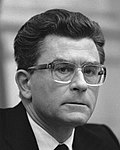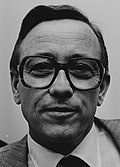Ministers Title/Ministry /Portfolio(s) Term of office Party Dries van Agt (1931–2024) Prime Minister General Affairs 19 December 1977 – [Retained] Christian Minister Foreign Affairs 29 May 1982 – Jan Terlouw (1931–2025) Deputy Economic Affairs 11 September 1981 – [Retained] Democrats 66 Minister Max Rood (1927–2001) Minister Interior 29 May 1982 – Democrats 66 Fons van der Stee (1928–1999) Minister Finance 5 March 1980 – [Retained] Christian Job de Ruiter (1930–2015) Minister Justice 19 December 1977 – [Retained] Christian Hans van Mierlo (1931–2010) Minister Defence 11 September 1981 – [Retained] Democrats 66 Til Gardeniers- (1925–2019) Minister Health and 11 September 1981 – [Retained] Christian Louw de Graaf (1930–2020) Minister Social Affairs and 29 May 1982 – Christian Wim Deetman (born 1945) Minister Education and 29 May 1982 – [Continued] Christian Henk Zeevalking (1922–2005) Minister Transport and 11 September 1981 – [Retained] Christian Jan de Koning (1926–1994) Minister Agriculture and 11 September 1981 – [Retained] Christian Minister Interior • Netherlands 29 May 1982 – [Continued] Erwin Nypels (1933–2024) Minister Housing and 29 May 1982 – Democrats 66 Hans de Boer (born 1937) Minister Culture, Recreation 29 May 1982 – [Note] Christian Til Gardeniers- (1925–2019) 11 October 1982 – [Acting] Christian Minister without portfolio Title/Ministry /Portfolio(s) Term of office Party Kees van Dijk (1931–2008) Minister Foreign Affairs • Development 11 September 1981 – [Retained] Christian State Secretaries Title/Ministry /Portfolio(s) Term of office Party Gerard van (1928–2001) State Secretary Interior • Municipalities Emergency Minorities 11 September 1981 – [Retained] Christian Hans van (1936–2025) State Secretary Foreign Affairs • European Union Benelux 11 September 1981 – [Retained] Christian Michiel (born 1939) State Secretary Justice ) • Immigration Civil Law 11 September 1981 – [Retained] Democrats 66 Piet van Zeil (1927–2012) State Secretary Economic Affairs • Small and Regional Tourism 11 September 1981 – [Retained] [Continued] Christian State Secretary Social Affairs and • Occupational Elderly Care Disability Policy 12 June 1982 – Wim Dik (1939–2022) State Secretary Economic Affairs • Trade and Export 11 September 1981 – [Retained] Democrats 66 Jan van (1939–2013) State Secretary Defence ) • Human Equipment 14 September 1981 – [Retained] [Continued] Christian Ineke Lambers- (1946–2014) State Secretary Health and • Environmental Food Policy 11 September 1981 – [Retained] Democrats 66 Ad Hermes (1929–2002) State Secretary Education and • Primary Special Adult 9 January 1978 – [Retained] Christian 

























